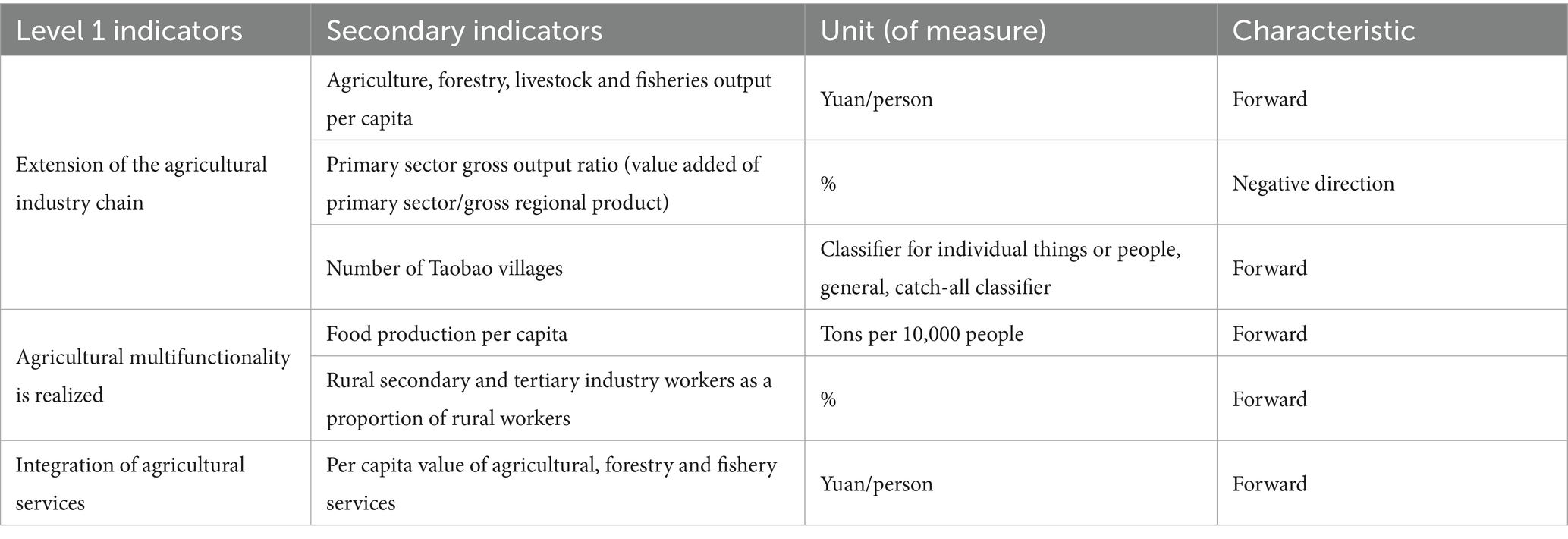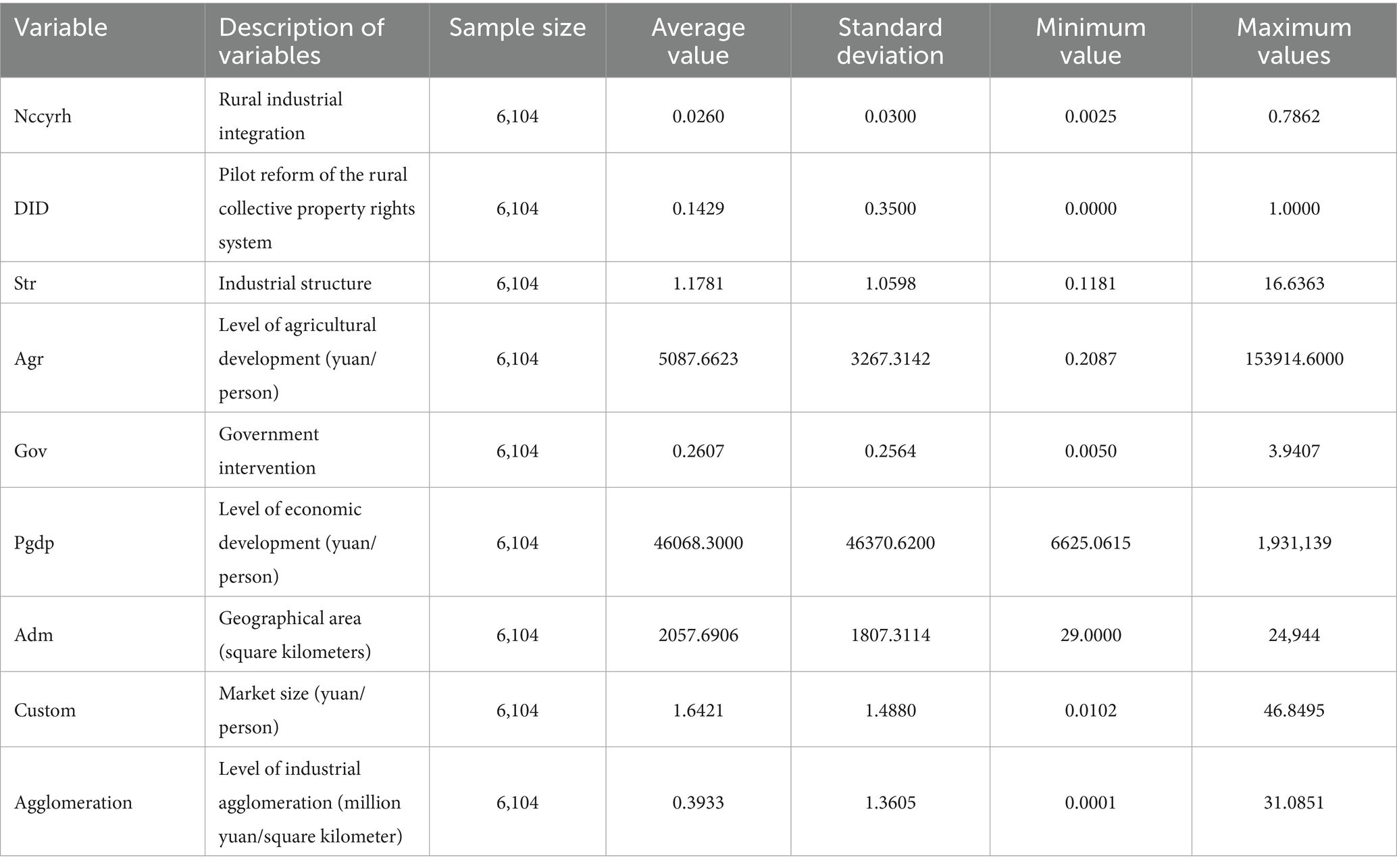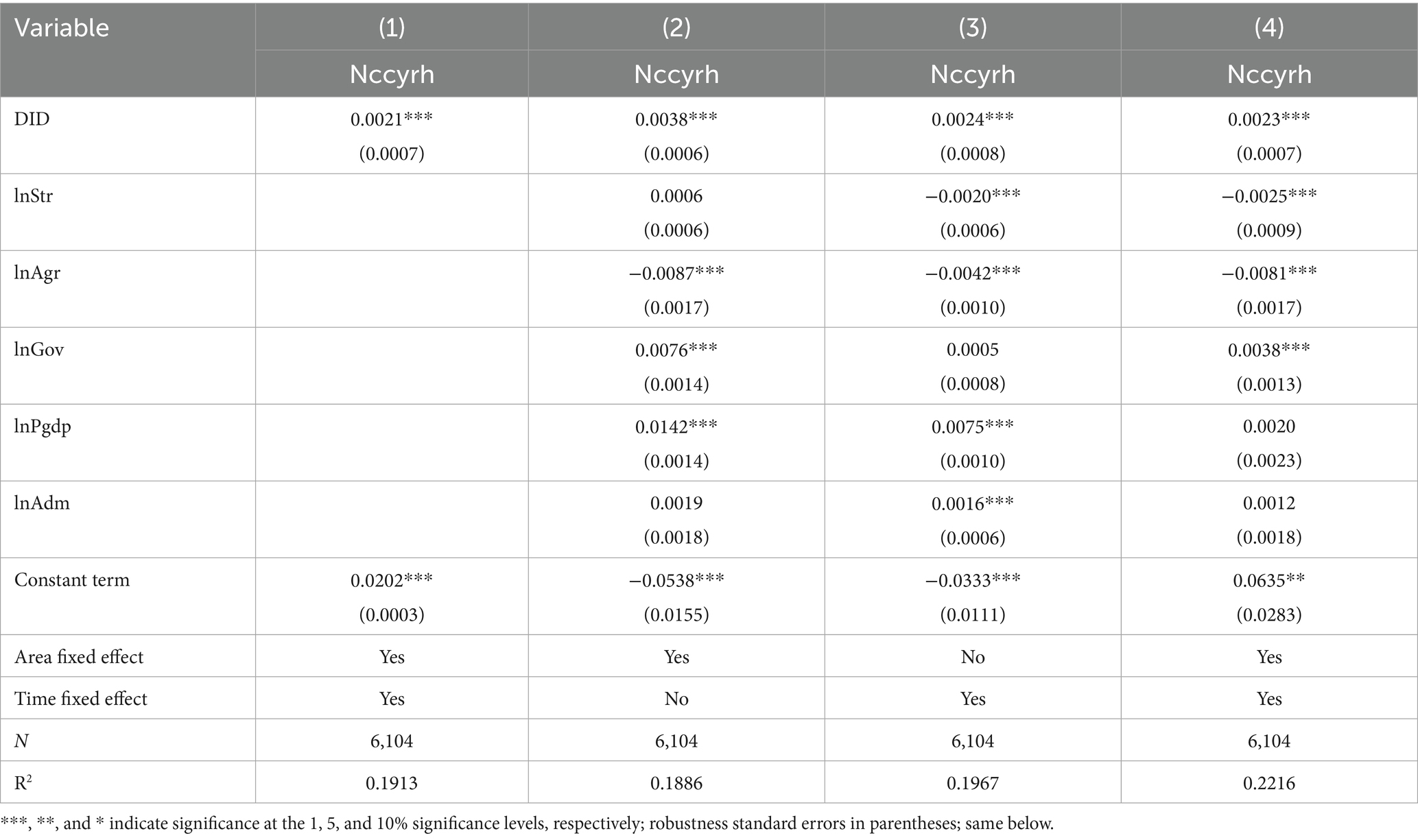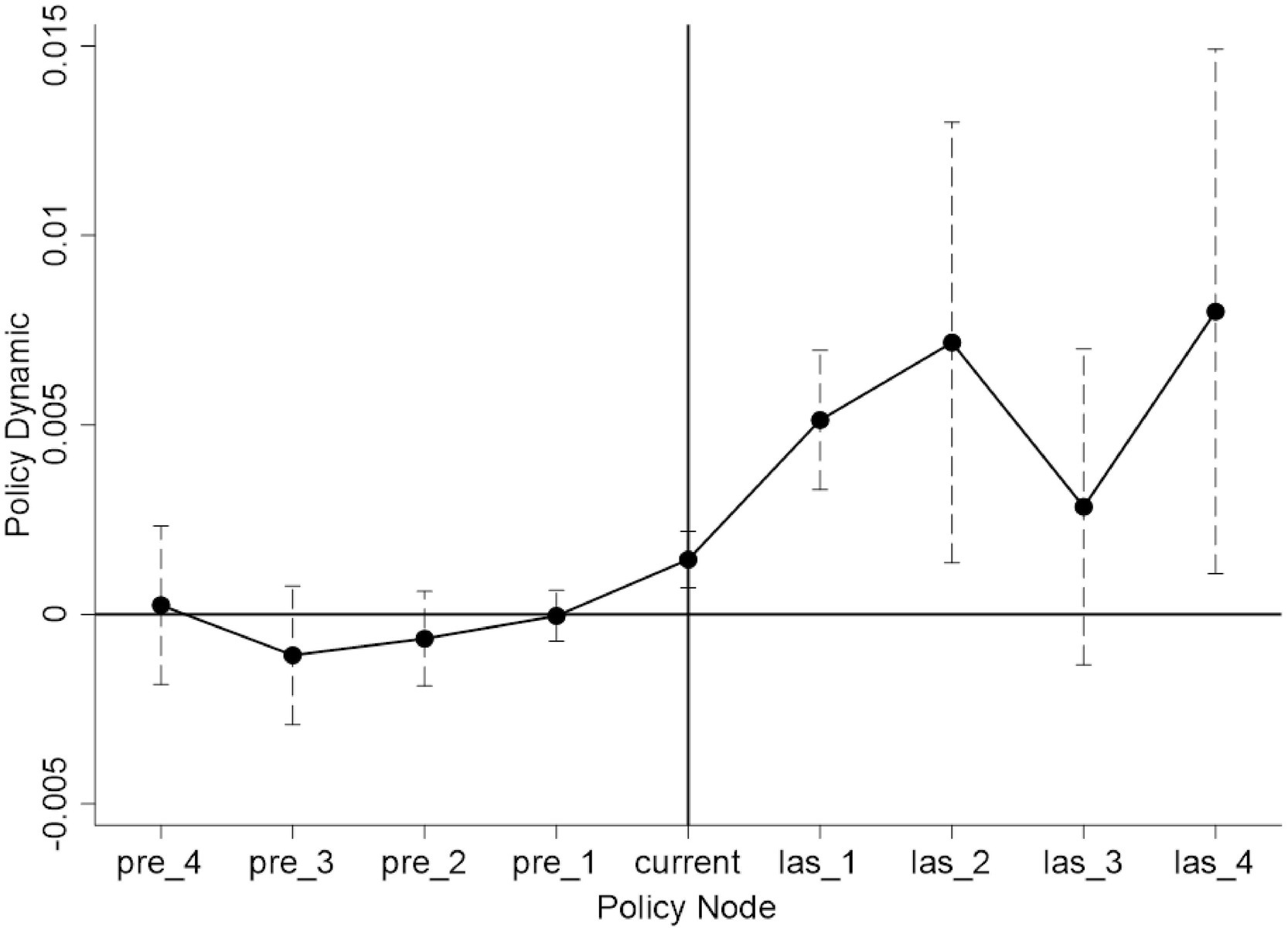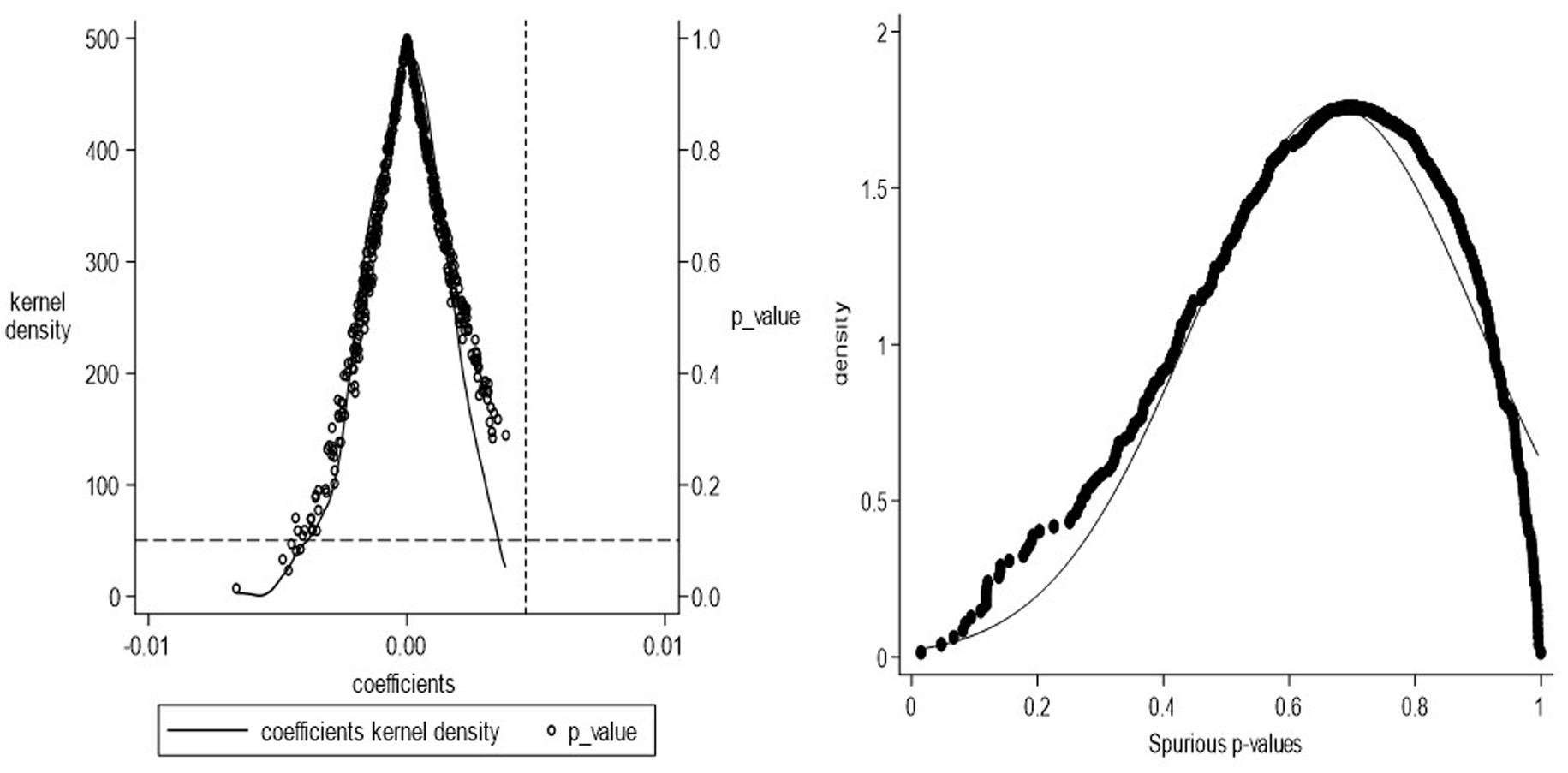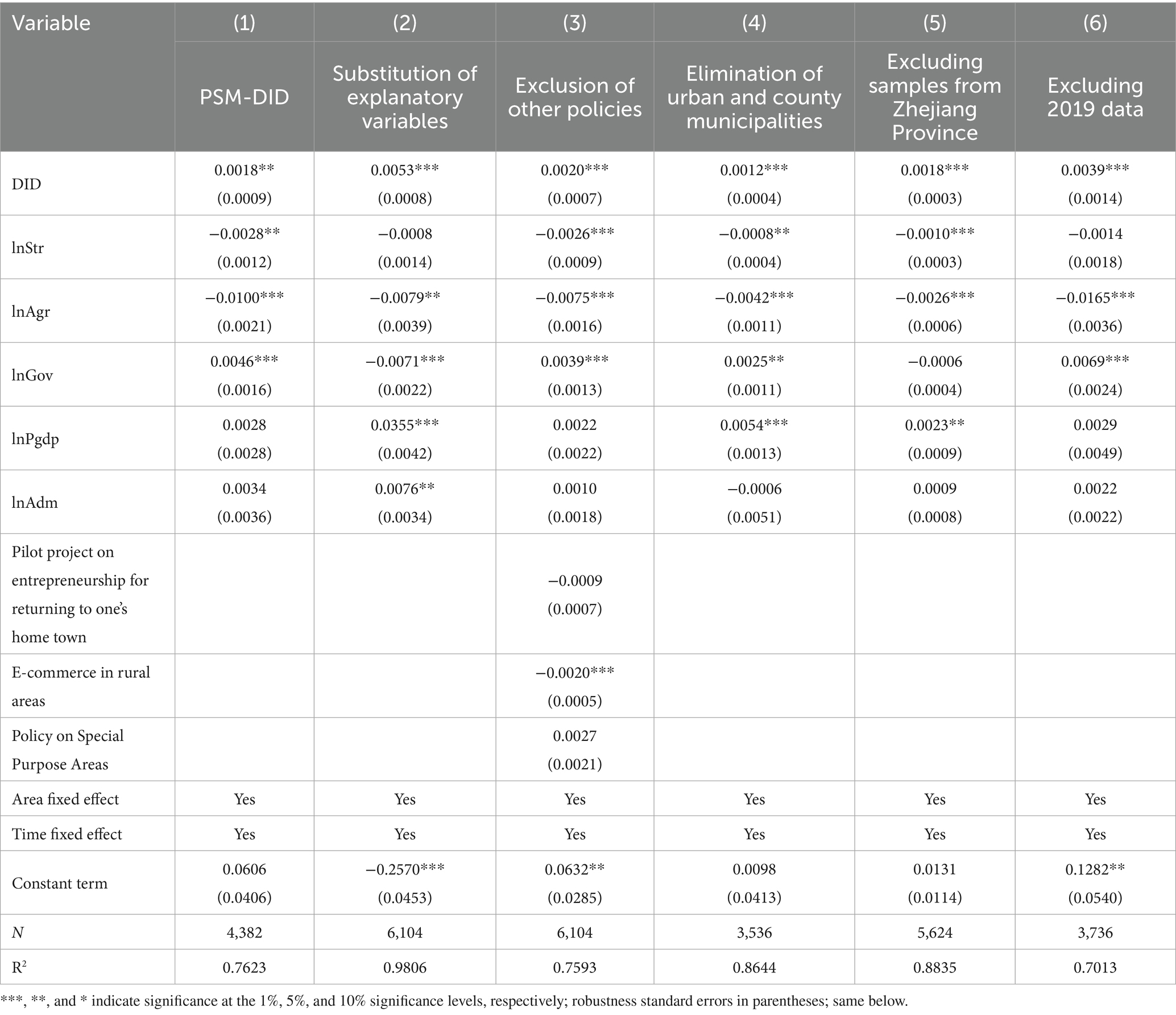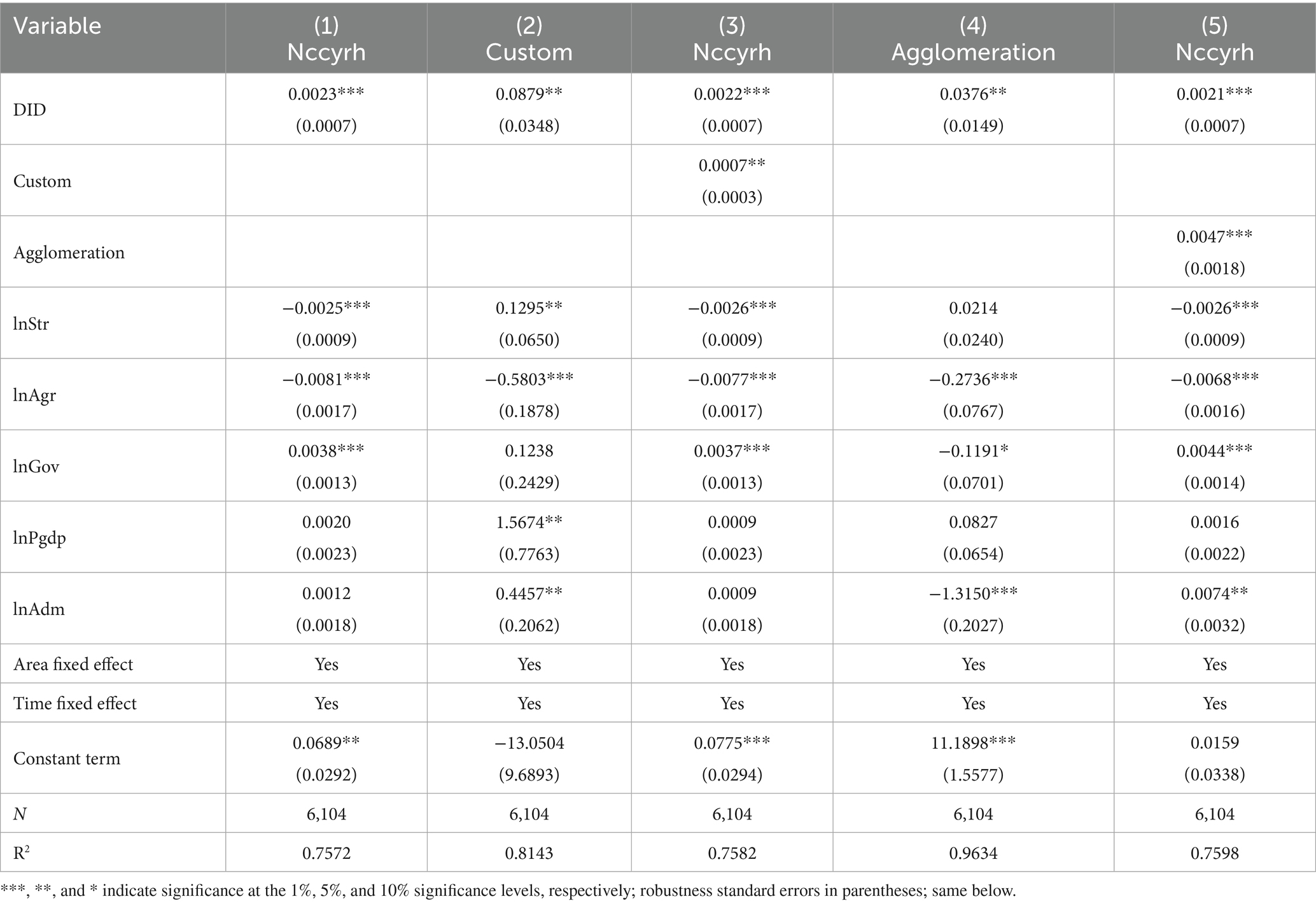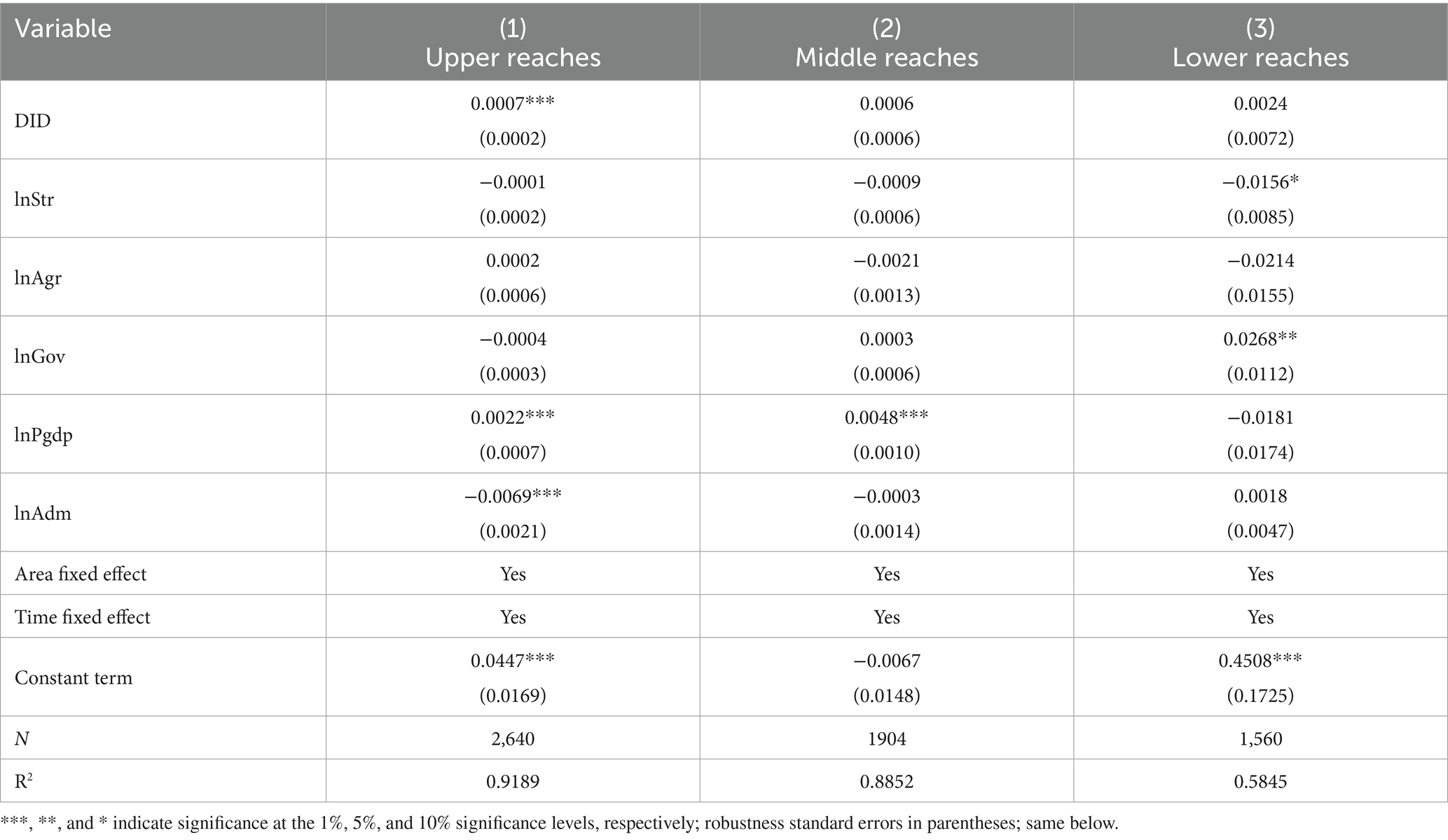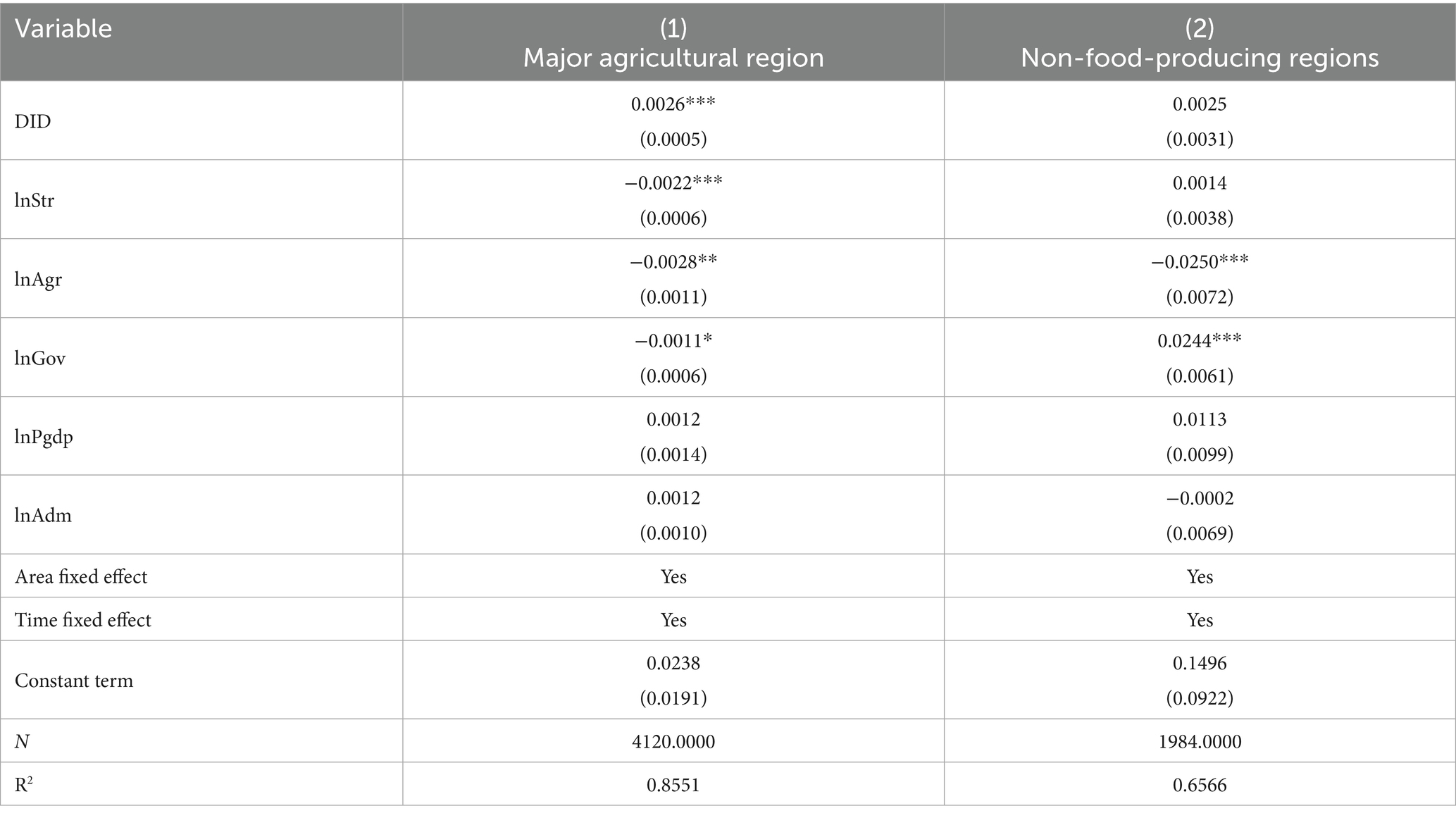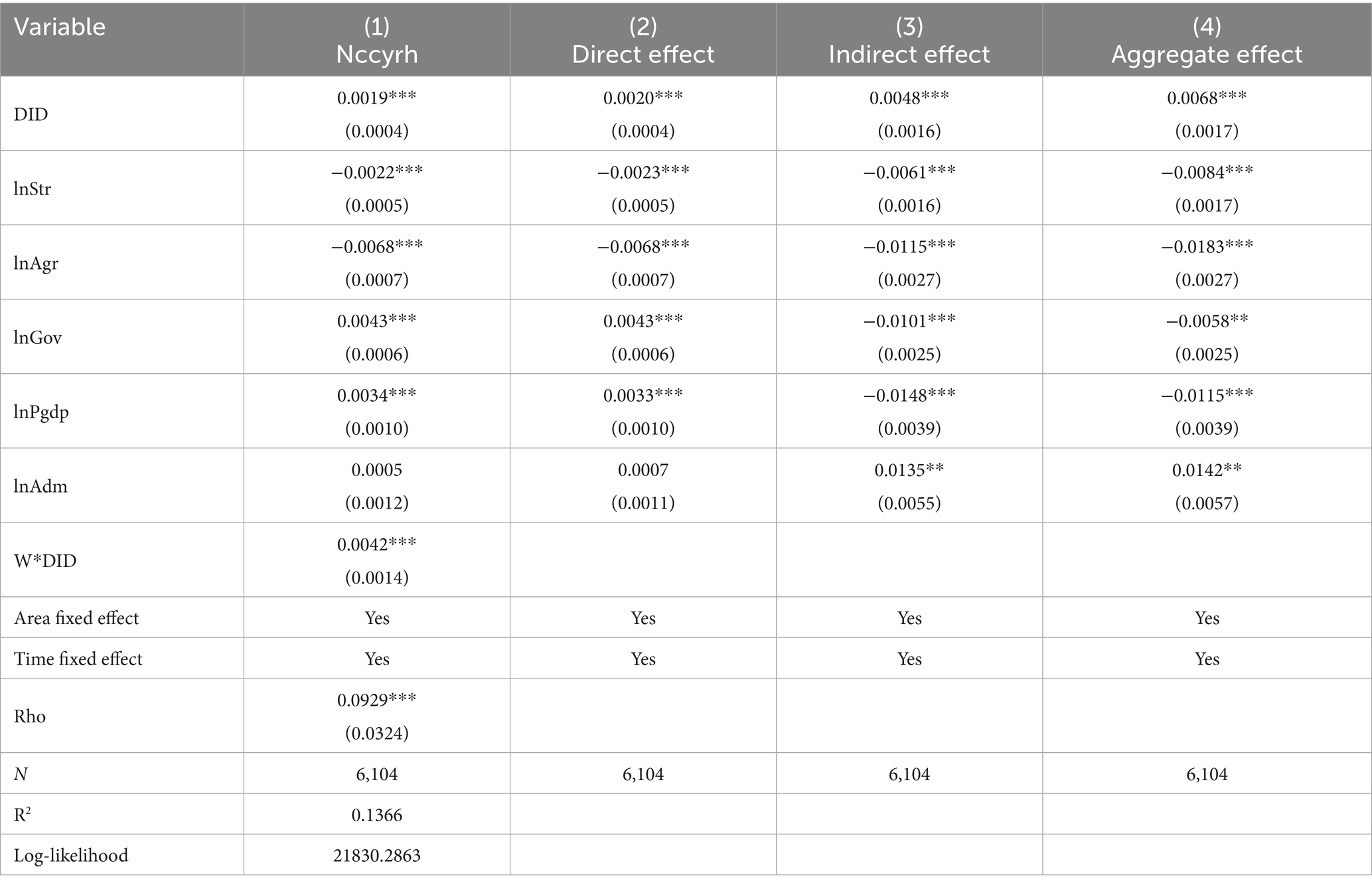- School of Public Administration and Law, Hunan Agricultural University, Changsha, China
As a critical component of China’s rural reform, the rural collective property rights system reform offers substantial institutional support for advancing rural industrial integration by clarifying and delineating property rights. Utilizing panel data from 763 counties in the Yangtze River Economic Belt spanning 2012 to 2019, this study investigates the effects of rural collective property rights system reform on rural industrial integration, employing a multi-period difference-in-differences model as a quasi-natural experiment based on a pilot reform initiative. The findings indicate that, first, the rural collective property rights system reform significantly enhances rural industrial integration. This conclusion remains valid after robustness testing, confirming the causal relationship between the reform of the rural collective property rights system and the integration of rural industries, while also avoiding model estimation errors caused by sample selection bias and reverse causality. Second, the reform facilitates rural industrial integration by expanding the county-level market scale and elevating industrial agglomeration levels. Third, in the upper reaches of the Yangtze River Economic Belt, the reform significantly promotes rural industrial integration, whereas its effect is less pronounced in the middle and lower reaches; similarly, in major grain-producing areas with a stronger agricultural foundation, the reform markedly enhances rural industrial integration, though its impact is less evident in non-grain-producing regions. Fourth, rural collective property rights system reform has a significant promotional effect on the integration of rural industries in neighboring areas by enabling the sharing of technology, talent, and capital between regions.
1 Introduction
Rural industrial integration constitutes a vital strategy for establishing a modern agricultural industrial system and an essential prerequisite for advancing agricultural modernization with Chinese characteristics. The underlying logic of rural industrial integration hinges on agriculture as its foundational core, leveraging industrial linkages, agglomeration, institutional innovation, and technological diffusion to seamlessly integrate agricultural production, processing, and sales with related service sectors, thereby achieving internal agricultural integration, extending the agricultural value chain, and enhancing agricultural multifunctionality, which collectively optimize and restructure rural resource elements and foster mutually beneficial outcomes for diverse stakeholders (Xiao and Du, 2019). Subsequently, how can the integrated development of rural industries be effectively advanced? Broadly, the integrated development of rural industries relies on the strengthening of the rural collective economy, which consolidates regional resources and labor to form competitive, multi-tiered industrial clusters, thereby facilitating the integration of agriculture, processing, and sales services, and establishing the foundation for the convergence of the primary, secondary, and tertiary sectors in rural areas (Xu, 2023). However, challenges such as ambiguous ownership of rural collective property rights and poorly defined rights and responsibilities undermine the vitality of the collective economy (Wei and Kong, 2024), potentially impeding the progress of rural industrial integration. Following the directives of the 2015 Central Document No. 1, which explicitly mandated clarifying the ownership of rural collective property rights, quantifying and allocating assets to members of collective economic organizations, and enhancing the management and oversight of the rural collective “three capitals” (assets, funds, and resources) alongside the income distribution system, the reform of the rural collective property rights system not only bolsters the vitality of the rural collective economy but also revitalizes idle rural resources, such as land, and fosters the emergence of new rural management entities, thereby providing momentum for advancing rural industrial integration. Thus, can the reform of the rural collective property rights system effectively enhance rural industrial integration, and what mechanisms underpin its influence? A rigorous analysis addressing these questions will not only enable a precise evaluation of the reform’s impact on rural industrial integration but also hold substantial importance for advancing rural industrial integration and supporting rural revitalization.
2 Literature review
Currently, scholars have conducted extensive research on rural industrial integration, primarily concentrating on the following areas: first, developing an indicator system to assess rural industrial integration based on its fundamental concepts. For instance, Xie et al. (2024) developed an evaluation index system encompassing five dimensions: extension of the agricultural industry chain, expansion of agricultural multifunctionality, cultivation of novel agricultural business models, integration of the agricultural service sector, and enhancement of benefit-sharing mechanisms. Li and Tian (2024) established an evaluation index system based on three key dimensions—extension of the agricultural industry chain, expansion of agricultural multifunctionality, and integration of agricultural services—tailored to the characteristics of county-level economic data and data availability. Additionally, some scholars have proposed an evaluation index system for rural industrial integration grounded in the five development concepts of innovation, coordination, sustainability, openness, and inclusivity (Guan, 2016). Second, research examines the economic and ecological impacts arising from rural industrial integration. For instance, Li et al. (2017) employed propensity score matching (PSM) analysis to empirically evaluate the effect of rural industrial integration on farmers’ income, concluding that it significantly enhances farmers’ income compared to the traditional agricultural development model. Chen Yuying analyzed county-level panel data using a multi-period difference-in-differences approach, finding that rural industrial integration significantly boosts farmers’ income, with more pronounced income effects in agricultural counties and those with higher economic development levels (Chen, 2024). Luo and Wei (2022b) posited that rural industrial integration primarily enhances the rural ecological environment and fosters sustainable agricultural development by promoting large-scale agricultural operations, strengthening rural human capital, and advancing agricultural technology. Li and Shi (2024) empirically demonstrated that rural industrial integration indirectly achieves a “carbon reduction effect” by optimizing labor, land, technology, and other resources. Third, studies investigate the factors influencing rural industrial integration. At the macro level, research has primarily assessed the effects of the digital economy (Yan and Cao, 2024), digital inclusive finance (Ge et al., 2022), and financial support (Li et al., 2024) on rural industrial integration. At the micro level, research has predominantly examined the influence of factors such as emerging agricultural entities (Zhao et al., 2023), the development of modern agricultural parks (Sun et al., 2024), and high-standard farmland construction (Wu et al., 2025) on rural industrial integration.
In contrast to the influencing factors outlined earlier, certain studies have examined the effects of rural collective property rights system reform on rural industrial development. As a pivotal component of China’s rural reform, pertinent academic research exploring the effects of rural collective property rights system reform on rural industrial development has predominantly concentrated on two key areas: rural economic development and rural revitalization. For instance, regarding rural economic development, Li and Tang (2023) utilized China Household Finance Survey panel data to investigate how rural collective property rights system reform enhances rural household income growth by invigorating emerging business entities, fostering employment through new agricultural entities, and increasing farmers’ property-derived income. Jiang et al. (2021) analyzed Chinese provincial-level data to demonstrate that rural collective property rights system reform boosts rural household business and wage income by improving the efficiency of large-scale operations and facilitating farmers’ non-farm employment. Luo and Wei (2022a) empirically assessed the effect of rural collective property rights system reform on the urban–rural income gap at the county level using county-level data, concluding that the reform significantly accelerates rural economic growth and exerts a notable convergence effect on the urban–rural income disparity. Xiang et al. (2024) determined that rural collective property rights system reform fosters rural economic development, transforms the rural economic structure, and reduces rural poverty. Regarding rural revitalization, certain scholars argue that the rural collective property rights system constitutes a core element of the institutional and policy framework supporting the rural revitalization strategy (Tong and Wei, 2019) and serves as critical institutional support and assurance for its implementation (Cheng, 2018). In addition, rural collective property rights reform can significantly enhance villagers’ public participation, expression of interests, and voting rights (Li and Gao, 2025), thereby improving the happiness of rural residents (Liu et al., 2024). Research most relevant to this paper indicates that China’s rural collective property rights system reform seeks to establish a novel rural collective economic organization with a well-defined property rights structure (Kong, 2020), thereby converting collective assets from a “common share” to a “share in common” framework, enhancing farmers’ enthusiasm for engaging in rural development, and subsequently enabling regions to leverage their unique strengths to develop processing and tourism industries, which not only advances county-level economic growth but also provides substantial momentum for rural industrial development (Ding, 2022).
In summary, there have been many useful studies on the reform of the rural collective property rights system and the integration of rural industries, but there are fewer studies on the relationship between the reform of rural collective property rights system and rural industrial integration, and fewer studies have explored the impact of the reform of rural collective property rights system and its mechanism on rural industrial integration at the county level, and analyzed its spatial spillover effects. The innovative aspects of this paper are primarily threefold: First, starting from the county level, we integrate rural collective property rights reform and rural industrial integration into a unified analytical framework. Using panel data from counties along the Yangtze River Economic Belt, we construct a multi-period difference-in-differences model to explore the impact effects and mechanisms of rural collective property rights reform on rural industrial integration, and discuss its heterogeneity across geographical locations and grain-producing regions. Second, this paper employs a mediation effect model for empirical analysis, revealing the mechanism through which rural collective property rights system reform promotes rural industrial integration by expanding county-level market scale and enhancing industrial agglomeration levels. Third, by constructing a spatial Durbin model, we examine the spatial spillover effects of rural collective property rights system reform on rural industrial integration.
3 Policy background and theoretical analysis
Advancing rural collective property rights system reform is an urgent necessity to enhance the vitality of rural collective economic development. As a unique institutional arrangement in China, the reform of the rural collective property rights system has clarified the property rights relationships of rural collective assets, defined the property rights capacity of collective economic organizations, and created opportunities for promoting rural industrial integration. This section, after briefly outlining the policy background, aims to analyze the impact of the reform of the rural collective property rights system on rural industrial integration, elucidate its underlying logic, and propose research hypotheses.
3.1 Policy context
The reform of the rural collective property rights system is an institutional innovation that, based on clarifying the ownership of collective assets, takes shareholding cooperation as its main form and focuses on asset inventory and valuation, asset quantification, member identification, equity allocation, equity management, and profit distribution. It involves converting the assets managed by rural collectives into shares and quantifying them to individuals and households, thereby clarifying the market entity status of collective economic organizations. As early as the 1980s, China initiated explorations into reforming the rural collective property rights system. In the 1990s, certain scholars examined the structuring of China’s rural property rights system, advocating for a clear delineation of the rural cooperative economic system as the foundational microeconomic framework suited to China’s contemporary rural market economy, while emphasizing that its reconstruction should align with the dual principles of efficiency and equitable prosperity (Zhu and Chen, 1993). However, as China’s socialist market economy rapidly evolved, issues such as ambiguous property rights relationships and poorly defined functional roles within the rural collective economy progressively impeded its development, resulting in its persistent marginalization and lag relative to other economic sectors in rural areas (Luan, 2024). In 2024, the Ministry of Agriculture and Rural Affairs, the Central Agricultural Affairs Office, and the State Forestry Administration jointly issued the “Pilot Reform Program for Actively Developing Farmers’ Shareholding Cooperatives to Empower Farmers with Shares in Collective Assets,” explicitly proposing the establishment of a socialist rural collective property rights system with Chinese characteristics to safeguard the legitimate rights and interests of rural collective economic organizations and their members, enhance farmers’ property income, and formally initiate the reform of the rural collective property rights system. Since 2015, the Ministry of Agriculture and Rural Affairs has implemented four nationwide batches of rural collective property rights system reform pilots, steadily advancing the reform process. In 2020, Central Document No. 1 called for a comprehensive advancement of the rural collective property rights system reform pilot, including the systematic confirmation of collective membership, quantification of collective asset shares, reform of the shareholding cooperative system, and registration and coding of collective economic organizations. By the end of 2021, the phased objectives of the rural collective property rights system reform were largely achieved, with the reform not only finalizing the liquidation and clarification of rural collective assets but also revitalizing the rural factor market and establishing a robust institutional foundation for the rural revitalization strategy (Table 1).
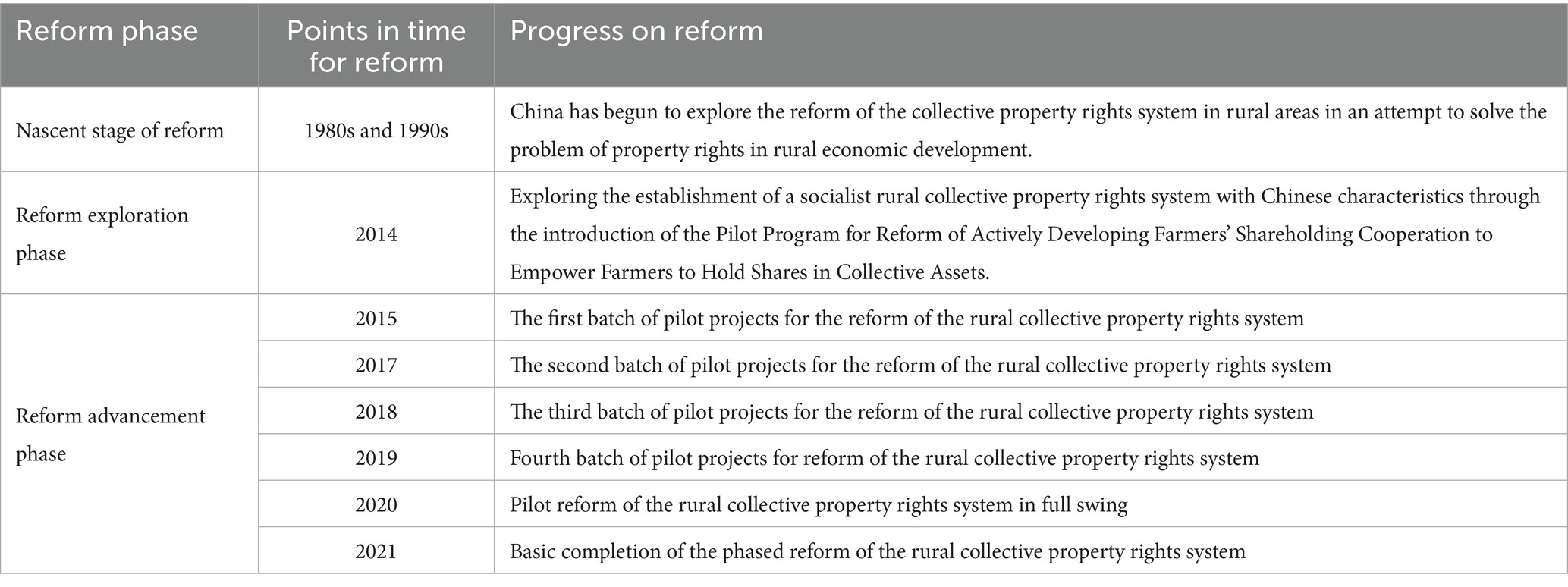
Table 1. Stages and progress of the reform of China’s collective property rights system in rural areas.
3.2 Theoretical analysis
Broadly, the primary objective of rural collective property rights system reform is to delineate the property rights relationships of rural collective assets, thereby providing a critical foundation for achieving large-scale rural land operations and enhancing the operational capacity of collective economic entities, while also supplying intrinsic momentum for advancing the integrated development of rural industries. Specifically, first, the clear definition of rural collective property right relationship can give farmers more rights to know and participate in collective assets, diminishes their role as mere owners of collective economic organizations, and reinforces their positions as proprietors and contributors of collective resource elements (Zhang, 2019). This liberation frees farmers from entrenched rural social constraints, encouraging their use of collective assets to develop agriculture-related industries, thereby providing intrinsic motivation and capacity to foster agricultural industry integration. Furthermore, this reform has spurred farmers to leverage collective assets for developing agriculture-related industries, thereby enhancing the agricultural industry’s functionality, increasing the added value of agricultural products, and promoting agriculture’s multifunctional expansion. Second, the reform of the rural collective property rights system clarifies the land property rights framework, mitigates land mismatch and agricultural fragmentation, thereby facilitating large-scale rural land operations and enhancing agricultural production efficiency. This not only disrupts the bidirectional dependency between farmers and land, freeing more labor to participate in rural secondary and tertiary industries and thereby promoting rural industrial structural adjustment, but also fosters the optimal allocation of resource elements—such as information, capital, and technology—across industries, further supporting agricultural industry advancement and providing momentum and resource support for the integrated development of rural industries (Zeng et al., 2022). Third, the reform of the rural collective property rights system strengthens the property rights capacity of collective economic organizations by quantifying rural collective operating assets into shares, thereby fostering their external collaboration and internal development (Liang and Li, 2018), positioning them as key drivers of rural industrial integration. Within this framework, collective economic organizations can attract investment by revitalizing idle housing and land, while simultaneously encouraging migrant workers to return for entrepreneurial and employment opportunities (Zhang and Xu, 2022) and drawing social capital into rural areas, thereby enabling the development of agricultural product processing, leisure tourism, cultural creativity, and other emerging industries (Chen and Sun, 2020). This enhances job creation, strengthens the rural community’s wealth-generating capacity, improves the efficiency of collective resource allocation, and promotes the extension of the agricultural industry chain and rural industrial diversification, collectively advancing the integration of agriculture with secondary and tertiary industries. Building on this analysis, this study proposes the following research hypotheses.
H1: The reform of the rural collective property rights system can effectively promote rural industrial integration.
Given that a well-defined property rights relationship and protection system facilitates the inter-regional flow of factors such as rural land, capital, and talent, which in turn supports market scale expansion and elevates industrial agglomeration levels (Li X., 2024), thereby influencing rural industrial integration, this study investigates the mechanisms through which rural collective property rights system reform influences rural industrial integration, from the dual perspectives of market scale and industrial agglomeration.
First, rural collective property rights system reform promotes rural industrial integration by expanding market scale. On one hand, by clarifying property rights, this reform converts idle rural assets into tradable commodities or services, fostering the standardized development of rural land and factor markets, thereby enabling collective economic organizations to secure stable capital income, enhancing their investment capacity and resource allocation efficiency, and increasing the supply of high-quality commodities and services, which expands market supply scale. Simultaneously, by optimizing the property rights incentive mechanism, the reform facilitates large-scale land operations and boosts agricultural income, thereby enhancing agriculture’s appeal and encouraging the return of migrant laborers, driving the free flow of modern production factors, equipment, and technology between urban and rural areas, while also expanding and upgrading the rural consumer market (Wei and Luo, 2024), thus creating conditions for market scale expansion. On the other hand, market scale expansion increases consumer demand for both the quantity and quality of agricultural products, prompting a shift in agricultural development from traditional cultivation toward specialized, ecological, and sustainable practices, which endows the agricultural industry with new functions, enhances the added value of agricultural products, and fosters rural industrial integration. Furthermore, this expansion creates greater profit potential, attracting social capital to rural areas and promoting innovations in agricultural technology, equipment upgrades, and product branding, thereby extending agriculture into processing and service sectors, fostering a multidimensional, composite agribusiness model integrating production, processing, logistics, and scientific and technological R&D (Zhu et al., 2018), which supports rural industrial integration. Building on this analysis, this study proposes the following research hypothesis:
H2: Rural collective property rights system reform promotes rural industrial integration by expanding market scale.
Second, rural collective property rights system reform promotes rural industrial integration by enhancing industrial agglomeration. On one hand, by registering land rights and reforming the joint-stock cooperation system, this reform effectively addresses issues of unclear ownership and limited circulation of rural land property rights, facilitating large-scale land circulation and centralized resource allocation, thereby creating conditions for enterprise spatial agglomeration. Simultaneously, it promotes the free flow of regional resource elements and enhances resource allocation efficiency, fostering the regional industrial agglomeration effect (Wang et al., 2019). On the other hand, industrial agglomeration refines the production chain, lowers costs, and drives technological progress through economies of scale and knowledge spillovers, thereby upgrading the industrial structure (Duan and Liu, 2024) and supporting rural industrial integration. The economies of scale from agglomeration reduce enterprise production costs, attract external capital to rural areas, and promote deeper integration of agriculture with processing, logistics, and tourism sectors, accelerating rural industrial integration. Simultaneously, agglomeration’s externalities foster regional enterprise cooperation and exchange through knowledge sharing and technology diffusion, driving the transformation and modernization of traditional agriculture (Ding and Gao, 2025). Furthermore, agglomeration attracts more agricultural and related upstream and downstream enterprises through regional synergies and brand development, refining the industrial division of labor and extending the agricultural industry chain, thereby fostering rural industrial integration. Building on this analysis, this study proposes the following research hypothesis:
H3: Rural collective property rights system reform promotes rural industrial integration by enhancing industrial agglomeration.
4 Study area, methodology and data sources
4.1 Overview of the study area
The Yangtze River Economic Belt spans eastern, central, and western China, led by Shanghai, encompassing 11 provinces and municipalities—including Jiangsu and Zhejiang—covering approximately 21% of China’s land area and accounting for roughly 40% of its population and economic output. As China’s east–west economic development axis, the Yangtze River Economic Belt is endowed with abundant agricultural resources and favorable production conditions, while also serving as a key economic development zone and a primary agricultural production region. In recent years, rural areas within the Yangtze River Economic Belt have actively pursued innovative practices, integrating agricultural and industrial resources across regions, fostering the interpenetration and integration of agriculture with related industries, and facilitating cross-sectoral reorganization, which has spurred the emergence of new industries, business models, and the extension of the agricultural industry chain (Cheng et al., 2024). This has positioned the Yangtze River Economic Belt as a paradigmatic region for the integrated development of rural industries nationwide. Concurrently, in alignment with new urbanization initiatives and the rural revitalization strategy, several provinces and municipalities within the Yangtze River Economic Belt are actively exploring rural collective property rights system reform to stimulate the rural factor market and foster rural economic development. Given the variations in economic development levels, resource endowments, and reform foundations across provinces and municipalities in the Yangtze River Economic Belt, the approaches to rural collective property rights system reform and their implementation efforts exhibit diverse characteristics, with potentially distinct and representative impacts on rural industrial integration. Thus, this study adopts the Yangtze River Economic Belt as its research focus, enabling it to elucidate both the general patterns and shared characteristics of China’s rural collective property rights system reform, as well as the differential impacts of this reform on rural industrial integration across varying regional development stages and reform models, offering significant insights for advancing rural collective property rights system reform and fostering rural industrial integration.
4.2 Modeling
In this study, the pilot reform of the rural collective property rights system is treated as a quasi-natural experiment, with counties (including cities and districts) that implemented the rural collective property rights system during the sample period assigned to the experimental group, and those that did not implement it assigned to the control group. Given that the reform pilot is implemented in phases, a multi-period difference-in-differences (DID) method is employed to assess the impact of rural collective property rights system reform on rural industrial integration. The model developed in this study is specified as follows:
In the Equation 1, is the county (city, district); is the year; the explanatory variable denotes rural industrial integration; the core explanatory variable denotes a dummy variable reflecting the pilot reform of the rural collective property rights system; denotes the set of control variables, including the industrial structure, the level of agricultural development, the government’s intervention, the level of economic development, and the geographic area; denotes the individual fixed effects of the county (city, district) i; denotes the time fixed effects; is the intercept term; is the randomized disturbance term.
In order to further test the role path and mechanism of rural collective property rights system reform affecting rural industrial integration, this study constructs a mediation effect model for testing:
In Equations 2, 3, is the mediating variable, including market size and industrial agglomeration level; the rest of the variables are the same as in Equation 1.
4.3 Selection and description of variables
4.3.1 Explanatory variable
Rural Industrial Integration (Nccyrh). Current scholarship has yet to establish a standardized method for measuring rural industrial integration, with most studies relying on inter-provincial analyses. In this study, by reviewing the relevant literature on rural industrial integration and drawing on Zhang et al. (2021), rural industrial integration indicators are developed based on county-level data availability, encompassing three dimensions: agricultural industry chain extension, multifunctional agricultural utilization, and agricultural service industry integration (see Table 2). Agricultural industry chain extension depends on the vertical integration of agriculture, linking production, sales, and related processes to form a modernized agricultural system, as measured by per capita output value of agriculture, forestry, animal husbandry, and fisheries, the proportion of primary industry output value, and the number of Taobao villages. Multifunctional agricultural utilization reflects the linkage and deep integration of agriculture with high-value, growth-oriented industries, as indicated by per capita food output and the proportion of village employees in secondary and tertiary industries. Agricultural service industry integration represents the coordinated development of agriculture and the service sector, as evidenced by the per capita output value of agriculture, forestry, animal husbandry, and fishery services, demonstrating the interpenetration and integration of agriculture with the service sector. This study employs the entropy value method to process data, determine indicator weights, and compute a composite score for measuring rural industrial integration.
4.3.2 Core explanatory variables
Rural Collective Property Rights System Reform (DID). If a county (city or district) enters the list of rural collective property right system reform in the current year and the following years, it is assigned a value of 1; otherwise, it is assigned a value of 0.
4.3.3 Mediating variables
Based on the previous theoretical analysis, the pilot reform of the rural collective property rights system may have an impact on rural industrial integration through two paths: expanding the market scale and improving the level of industrial agglomeration, therefore, this paper introduces two intermediary variables, namely, the market scale and the level of industrial agglomeration, to conduct mechanism analysis. Market size (Custom) is measured by the total retail sales of consumer goods per capita; and industry agglomeration level (Agglomeration) is measured by the ratio of the actual value added of the second and third industries in the county to the area of the administrative region.
4.3.4 Control variables
In order to minimize the influence of unobservable factors, this paper refers to existing studies on rural industrial integration and selects the following control variables: industrial structure (Str) is expressed as the ratio of the actual value added of the tertiary industry in the county to the actual value added of the secondary industry in the county; the level of agricultural development (Agr) is expressed as the ratio of the actual value added of the primary industry in the county to the total population; Government intervention (Gov) is expressed as the ratio of fiscal expenditure to GDP; the level of economic development (Pgdp) is expressed as the ratio of county GDP to total population; and the area of territory (Adm) is expressed as the area of the county’s administrative region.
4.4 Data sources
Given that the pilot policy for rural collective property rights system reform was fully implemented across all provinces in the Yangtze River Economic Belt by 2020, and constrained by the availability of county-level data and missing values for relevant indicators, this study opts to use counties in the Yangtze River Economic Belt from 2012 to 2019 as the research sample. After excluding counties with significant data gaps, this study ultimately selects panel data from 763 counties (including cities and districts) across 11 provinces in the Yangtze River Economic Belt, spanning 2012 to 2019. Data on the pilot areas and implementation timing of the rural collective property rights system reform are sourced from the list of reform pilots published on the National Development and Reform Commission’s website from prior years; Taobao village data within the rural industrial integration index system are obtained from the Alibaba Research Institute; the remaining data are primarily sourced from the China County Statistical Yearbook, provincial and municipal statistical yearbooks, statistical bulletins of counties (including cities and districts), and the EPSDATA official website database, with a small amount of missing data imputed using the linear trend method. Descriptive statistics for all variables are presented in Table 3.
5 Analysis of empirical results
5.1 Baseline regression results
To examine the impact of rural collective property rights system reform on rural industrial integration, this study employs a two-way fixed effects model to estimate this relationship, with regression results presented in Table 4. As indicated in Table 4, the pilot reform of the rural collective property rights system exhibits a positive and statistically significant impact on rural industrial integration at the 1% level, irrespective of whether area and time effects are controlled or control variables are included, demonstrating that the reform significantly enhances rural industrial integration, thereby supporting Hypothesis 1. This suggests that rural collective property rights system reform facilitates rural industrial restructuring by optimizing land resource allocation and enabling large-scale land operations, thereby freeing labor to transition into secondary and tertiary industries. Concurrently, the reform strengthens the operational capacity of collective economic organizations by clarifying property rights relationships for collective assets and facilitating the quantification of collective operating assets, thereby stimulating the intrinsic motivation of these organizations to leverage collective assets for developing agriculture-related industries, fostering the extension of the agricultural industry chain, diversification of rural industries, and increased value-added of agricultural products, thus promoting rural industrial integration.
5.2 Parallel trend test
The double difference model needs to satisfy the parallel trend assumption, which is the basic premise for the estimation results to be valid. This paper refers to the existing research (Ferrara et al., 2012), analyzes the changes in rural industrial integration of the experimental group and the control group before and after the implementation of the pilot reform of rural collective property right system, and for this reason, this paper constructs the following model for the parallel trend test:
In Equation 4, is the coefficient to be estimated, which indicates the impact of the pilot reform of the rural collective property rights system on the integration of rural industries. s is the number of periods relative to the current period in which the pilot reform of the rural collective property rights system was carried out. The remaining variables are consistent with Equation 1.
The results are shown in Figure 1. In the four periods before the pilot, the regression coefficients are not significant, and at this time there is no significant difference between the experimental group and the control group in terms of statistical significance, i.e., the test of parallel trend passes. After the pilot, the regression coefficients show an upward trend and are significantly positive in the pilot period and the last two periods, and the level of rural industrial integration of the experimental group is significantly higher than that of the control group, which indicates that the pilot of the reform of the rural collective property rights system has produced a sustained impetus to the integration of the rural industry after the implementation of the pilot.
5.3 Robustness tests
5.3.1 Placebo test
In order to examine whether the estimation results are affected by some random factors, this paper refers to the existing literature (Bai et al., 2022), constructs the pseudo rural collective property rights system reform pilot variables, uses Stata software to extract some sample counties (cities and districts) from all the samples as the treatment group and the time of policy shocks is given randomly, repeats the process 500 times and re-double-difference estimation, and then obtains the virtual core The estimated coefficients of the explanatory variables and their corresponding p-values, and the results of the placebo test are shown in Figure 2. The results in Figure 2 show that the estimated coefficients of the dummy core explanatory variables are concentrated around 0, in line with the standard normal distribution, and the p-values are overwhelmingly over 0.1, while the estimated coefficients of the actual core explanatory variables are 0.0023, which is significantly different from the results of the placebo test, suggesting that the results of the benchmark regression are robust.
5.3.2 PSM-did
The selection of pilot areas for rural collective property rights system reform is not entirely random, as key objectives of the rural collective property rights system include increasing farmers’ property income, invigorating collective economic development, and guiding farmers toward shared prosperity, leading the government to potentially prioritize less-developed areas for piloting, thereby introducing sample selection bias. To address this, this study employs a multi-period propensity score matching difference-in-differences (PSM-DID) model to mitigate the resulting selection bias, utilizing nearest-neighbor matching without replacement for each treatment group in a 1:4 ratio, resulting in a matched sample of 4,382 observations, followed by regression analysis on the matched sample. As shown in column (1) of Table 5, the DID regression coefficient is significantly positive, consistent with prior findings, suggesting that the benchmark regression results remain robust.
5.3.3 Substitution of explanatory variables
At present, the academic community has not yet formed a unified indicator system and measurement method for the degree of rural industrial integration. Considering the intrinsic correlation of the integration of the three industries and the interaction mechanism of the three subsystems of the integration of rural primary, secondary and tertiary industries, this paper refers to the methodology of Chen and Cheng (2018) and uses the added value of the county’s primary, secondary and tertiary industries to measure the level of the development of the integration of rural industries. The specific calculation formula is as follows:
In Equations 5–7, denotes the level of rural industrial integration development, , , denote the county primary, secondary and tertiary industry development indexes respectively, and , , denote the coefficients of the three major industries, respectively, and take 1/3. Regression results are presented in column (2) of Table 5, where the DID estimated coefficient remains significantly positive at the 1% significance level, indicating that the baseline regression results remain robust.
5.3.4 Policies of exclusion of other interferences
Given that several national policies—including the pilot program for rural migrant workers returning to their hometowns to start businesses, the comprehensive demonstration counties for rural e-commerce, and the advantageous zones for agricultural products with Chinese characteristics—were sequentially introduced during the sample period, these policies may have influenced rural industrial integration. Among these, the policy encouraging rural migrant workers to return and start businesses enhances rural entrepreneurship and employment opportunities, disrupts the agriculture-dominated rural economic structure, and fosters rural industrial integration (Guo et al., 2024). Rural e-commerce acts as a platform for integrating agriculture, processing, logistics, and other industries, extending the rural industrial chain and thereby promoting rural industrial integration (Li Y., 2024). Additionally, the policy establishing China’s Characteristic Agricultural Product Advantageous Zones encourages farmers and new agricultural management entities to explore the value and cultural significance of distinctive agricultural products, thereby stimulating the development of agricultural product processing, rural tourism, and related industries, and consequently enhancing rural industrial integration (Chen and Yang, 2024). Consequently, this study incorporates these policy variables into the benchmark regression model and re-estimates the model. Regression results, presented in column (3) of Table 5, reveal that the pilot reform of the rural collective property rights system continues to exert a significantly positive impact on rural industrial integration, suggesting that the benchmark regression results remain robust.
5.3.5 Elimination of urban and county municipalities sample
Significant disparities exist between urban areas, county-level cities, and counties within the same region in terms of economic development and political status; thus, this study excludes urban areas and county-level city samples from the analysis and re-estimates the regression. Regression results are presented in column (4) of Table 5, where the DID regression coefficient is 0.0012 and remains significant at the 1% level, suggesting that the baseline regression results remain robust.
5.3.6 Excluding samples from Zhejiang Province
Given that Zhejiang Province had largely completed village-level reform tasks by 2015, to mitigate the potential bias in regression results arising from discrepancies between actual reform progress and the pilot implementation timeline in Zhejiang Province’s counties (including cities and districts), this study excludes samples from Zhejiang Province and re-estimates the regression. Regression results are presented in column (5) of Table 5, where the pilot reform of the rural collective property rights system yields a significantly positive coefficient at the 1% level, suggesting that the benchmark regression results remain robust.
5.3.7 Elimination of the sample of pilot counties selected for 2019
As this study cannot assess the long-term effects of the 2019 pilot reform of the rural collective property rights system on counties (including cities and districts) using data from 2012 to 2019, this limitation may influence the regression results. Consequently, this study excludes counties selected for the 2019 pilot reform of the rural collective property rights system and re-estimates the regression, with results presented in column (6) of Table 5, where the DID regression coefficient remains significantly positive at the 1% level, suggesting that the benchmark regression results remain robust.
6 Further analysis
6.1 Mechanism analysis
Previous theoretical analysis indicates that reforming the rural collective property rights system fosters rural industrial integration by expanding market scale and elevating industrial agglomeration levels. Accordingly, this study examines the mechanisms through which market scale and industrial agglomeration mediate this relationship by incorporating these variables into a mediation effect model. Adhering to established mediation effect testing procedures, this paper sequentially estimates Equations 2, 3 to investigate the influence of rural collective property rights system reform on rural industrial integration.
First, the direct effect of the reform on rural industrial integration is assessed. As reported in column (1) of Table 6, the reform exhibits a statistically significant positive effect on rural industrial integration. Next, the reform’s influence on market scale and industrial agglomeration is evaluated. According to columns (2) and (4) of Table 6, the regression coefficients for the reform’s impact on market scale and industrial agglomeration are 0.0879 and 0.0376, respectively, both statistically significant at the 5% level. These results suggest that the reform significantly contributes to market scale expansion and industrial agglomeration enhancement. Finally, the mediating effects of these variables on rural industrial integration are analyzed. By introducing market scale and industrial agglomeration as mediators into Equation 1, the regression results—presented in columns (3) and (5) of Table 6—demonstrate that the coefficient for market scale is significant at the 5% level, while that for industrial agglomeration is significant at the 1% level. These findings confirm that the reform promotes rural industrial integration through two distinct pathways: market scale expansion and increased industrial agglomeration. Consequently, Hypotheses 2 and 3 are substantiated. The reform of the rural collective property rights system has clarified property rights, transformed idle assets into market-based factors, enhanced the capital accumulation capacity of collective economic organizations, and resolved issues of unclear ownership and inefficient circulation of rural land rights. This has not only expanded the scale of market supply but also created conditions for the spatial agglomeration of enterprises. The profit-generating effects of market expansion attract social capital, driving agricultural technological innovation, equipment upgrades, and brand development, and promoting the extension of agriculture into the secondary and tertiary industries. Meanwhile, land rights clarification and shareholding cooperative reforms have resolved property rights ambiguity, facilitated large-scale land circulation, and created conditions for enterprise spatial agglomeration. Through industrial agglomeration, economies of scale, and knowledge spillover effects, production chains are optimized, costs are reduced, and technological upgrades are promoted, forming a diversified and integrated agricultural industrial system, thereby driving rural industrial integration.
6.2 Heterogeneity analysis
6.2.1 Geographic location heterogeneity
Given the variations in natural conditions and economic development levels across regions within the Yangtze River Economic Belt, this study further investigates the heterogeneous effects of rural collective property rights system reform on rural industrial integration. To this end, the 763 county-level samples are categorized into three major regions—upper, middle, and lower reaches of the Yangtze River Economic Belt—and regression results are presented in Table 7. As indicated in Table 7, the impact of the reform on rural industrial integration exhibits pronounced regional heterogeneity. Specifically, in the upper reaches, the reform exerts a statistically significant positive effect on rural industrial integration. In contrast, in the middle and lower reaches, the coefficient of the reform on rural industrial integration is positive but statistically insignificant. This disparity may stem from the relatively underdeveloped economic conditions in the upper reaches compared to the middle and lower reaches, prompting stronger governmental support for the collective economy in upstream areas. Such support, including increased funding and resource allocation, likely attracts more labor and enterprises to rural areas, thereby enhancing rural industrial integration. The priority given to economic development in the middle and lower reaches of the country has made it difficult for regional fiscal, tax and financial policies to effectively connect with the reform of the rural collective property rights system, and rural collective economic organizations have difficulty in obtaining sufficient financial support to carry out their economic projects, so the impact of the reform of the rural collective property rights system on the integration of rural industries has not been significant at this time.
6.2.2 Heterogeneity based on food-producing regions
To address the persistent decline in grain production, China’s Ministry of Finance issued the Opinions on Reforming and Improving Several Policy Measures for Comprehensive Agricultural Development in 2003, designating 13 provinces as main grain-producing regions (He et al., 2025). Among these, Jiangsu, Anhui, Hunan, Hubei, and Sichuan—located within the Yangtze River Economic Belt—fall within this category. Recognizing the heterogeneity in agricultural foundations across these grain-producing regions, this study further examines the differential impact of rural collective property rights system reform on rural industrial integration. Based on whether counties (cities and districts) belong to main or non-main grain-producing regions, the 763 county-level samples are divided into two groups, with regression results presented in Table 8. As shown in Table 8, the reform significantly enhances rural industrial integration in counties within main grain-producing areas, whereas its effect is statistically insignificant in non-main grain-producing areas. This disparity may arise from the flat terrain and highly specialized production patterns in main grain-producing areas, which facilitate the use of large-scale agricultural machinery and the expansion of planting areas, creating mature conditions for large-scale land management (Luo and Wei, 2023). Additionally, these regions typically possess superior agricultural infrastructure and higher production efficiency, providing a robust foundation for rural industrial integration. In this context, farmers, long accustomed to large-scale and specialized agricultural practices, exhibit advanced production techniques and market awareness, enabling them to adapt swiftly to the land scale and market-oriented operations introduced by the reform. Moreover, main grain-producing areas benefit from national food security strategies, including preferential policies and financial subsidies, which amplify the reform’s effects by fostering agricultural industrialization and extending the agricultural value chain. In contrast, the weaker agricultural base and limited farmer adaptability to market-oriented reforms in non-main grain-producing areas render the reform’s impact on rural industrial integration statistically non-significant.
6.3 Spatial spillover effects
The reform of the rural collective property rights system enhances land transfer efficiency and enables large-scale agricultural operations, which, through interregional economic linkages and industrial collaboration, can accelerate agricultural modernization in neighboring regions. Concurrently, this reform often fosters innovation and dissemination of agricultural technologies. The advanced technologies and management practices developed in reformed regions diffuse to adjacent areas via technical exchanges, personnel mobility, and related channels, generating a demonstration effect that promotes interregional technological synergy and rural industrial integration. Consequently, a spatial correlation may exist between the reform of the rural collective property rights system and rural industrial integration. To account for such spatial interdependence across regions, this study employs a spatial Durbin model (SDM) to examine the spatial effects of the reform on rural industrial integration. The model is specified as follows:
Equation 8 where p is the coefficient of the spatial lag term to be estimated for the explanatory variables; is the matrix of spatial weights of the selected economic geography; and θ is the coefficient of the spatial lag term of the core explanatory variables. The meanings of the other variables are the same as in Equation 1.
6.3.1 Spatial correlation test
To investigate the spatial spillover effects of rural collective property rights system reform on rural industrial integration, this study first assesses the spatial autocorrelation of rural industrial integration across 763 counties in the Yangtze River Economic Belt from 2012 to 2019, prior to applying a spatial econometric model. The global Moran’s I index is calculated using an economic-geographic spatial weight matrix, with results presented in Table 9. As reported in Table 9, the global Moran’s I values for rural industrial integration are consistently positive and statistically significant at the 1% level under the economic-geographic weight matrix. This finding confirms the presence of significant spatial correlation, thereby justifying the application of spatial econometric modeling in this analysis.
6.3.2 Analysis of regression results from spatial econometric models
To ensure proper specification of the spatial econometric model, this study sequentially conducts the LM test, LR test, Hausman test, and Wald test. Based on the results, the spatial Durbin model (SDM) is selected for estimation. As presented in Table 10, under the economic-geographic spatial weight matrix, the reform of the rural collective property rights system exhibits a statistically significant positive spatial spillover effect on rural industrial integration. To further dissect this spatial impact, this paper adopts the partial differential matrix decomposition method proposed by Elhorst (2014) to decompose the spatial effects of each variable, yielding a more precise assessment of spatial spillovers. According to column (2) of Table 10, the direct effect of the reform on rural industrial integration is significantly positive at the 1% level, corroborating the benchmark regression findings and reinforcing their robustness. Similarly, column (3) of Table 10 reveals a significantly positive indirect effect, indicating that the reform generates a positive spatial spillover effect on rural industrial integration in neighboring regions. This reform facilitates large-scale land operations, driving agricultural technology spillovers (Zeng and Fu, 2021), while also enhancing interregional flows of talent and capital, thereby fostering rural industrial prosperity in adjacent areas (Zhang and Long, 2024) and supporting the broader development of rural industrial integration.
7 Conclusions and policy implications
7.1 Conclusion
Utilizing panel data from 763 counties in the Yangtze River Economic Belt spanning 2012 to 2019, this study empirically evaluates the impact of rural collective property rights system reform on rural industrial integration. The key findings are as follows: First, the reform significantly enhances rural industrial integration. Second, the reform of rural collective property rights system promotes the integration of rural industries by expanding market scale and increasing industrial agglomeration levels. Third, the reform’s effect on rural industrial integration exhibits regional heterogeneity. In the upper reaches of the Yangtze River Economic Belt, the reform significantly promotes rural industrial integration, whereas its impact is statistically insignificant in the middle and lower reaches. Similarly, in main grain-producing areas—characterized by stronger agricultural foundations and advanced technologies—the reform markedly enhances rural industrial integration, but its effect is negligible in non-grain-producing areas. Fourth, the reform generates positive spatial spillover effects, promoting rural industrial integration in neighboring regions. However, this study also has certain limitations. First, in terms of the scope of the study, using the Yangtze River Economic Belt as the research area may limit the external validity of the research conclusions, and the sample data may not fully reflect the general patterns across the country. Second, in terms of data processing methods, to address the issue of missing data for certain years in the statistical yearbook, the study employed linear interpolation to fill in the gaps. While this method is reasonable, it may introduce systematic biases in the accuracy of certain estimated results. Therefore, future research could expand the scope of study by comparing the differentiated impacts of rural collective property rights system reforms on rural industrial integration across different regions, thereby enhancing the generalizability of research conclusions. Additionally, efforts could be made to collect broader and longer-term data, extending the observation period and expanding the sample coverage to strengthen the robustness of research conclusions.
7.2 Policy implications
First, to promote the integrated development of rural industries, policymakers should consolidate the achievements of the rural collective property rights system reform while deepening its implementation. Empirical evidence demonstrates that this reform significantly enhances rural industrial integration, both locally and in neighboring regions. Accordingly, local governments should grant greater autonomy to village collectives, encouraging active participation of members in the governance of the new rural collective economy. This can foster innovation in diverse forms of collective economic development, leverage region-specific rural resources, and diversify the traditionally rural industrial model, thereby advancing rural industrial integration. Simultaneously, governments must enhance policy coordination, strengthening the synergies between the reform of the “three types of land” (agricultural, construction, and homestead land) and the rural collective property rights system reform. Such alignment can improve land-use efficiency, facilitate economies of scale in land management, and progressively unlock reform dividends, promoting rural economic diversification and invigorating the endogenous drivers of rural industries. This integrated approach provides systemic support for rural industrial development. Furthermore, to maximize the spatial spillover effects of the reform, governments should establish cross-regional platforms for rural collective economic cooperation, facilitating resource sharing and experiential learning between regions. Increased investment in rural transportation and communication infrastructure is also essential to provide the foundational support needed to amplify the reform’s spatial spillover effects on rural industrial integration.
Second, policymakers should leverage the mediating effects of market scale expansion and industrial agglomeration in the rural collective property rights system reform to advance rural industrial integration. Governments should actively guide rural collective economic organizations to revitalize idle rural resources and enhance factor allocation efficiency through property rights transfers. Additionally, these organizations should be encouraged to develop distinctive agricultural product brands and broaden sales channels, thereby expanding county-level market scale. Concurrently, through targeted policy guidance and financial support, governments should promote the concentration of rural industries in advantageous areas, fostering competitive industrial clusters. This approach can facilitate synergies across upstream and downstream value chains, integrating agriculture with secondary and tertiary industries.
Third, the reform of the rural collective property rights system should be tailored to local conditions to optimize its impact on rural industrial integration. In the middle and lower reaches of the Yangtze River Economic Belt, as well as in non-grain-producing areas, the reform’s effect on rural industrial integration is statistically insignificant. In the middle and lower reaches, governments should provide tailored guidance and incentives, aligning regional fiscal and financial policies with rural collective property rights system reforms. This requires heightened regional focus on the reform, coupled with policy support and empowerment for collective economic organizations, to stimulate rural industrial integration. In non-grain-producing regions, the reform’s potential can be better harnessed by increasing investments in agricultural infrastructure and technological innovation, thereby strengthening the agricultural foundation and promoting the integrated development of rural industries.
Data availability statement
The raw data supporting the conclusions of this article will be made available by the authors, without undue reservation.
Author contributions
LZ: Supervision, Writing – review & editing, Conceptualization, Funding acquisition, Validation. ZL: Methodology, Formal analysis, Investigation, Data curation, Software, Writing – original draft.
Funding
The author(s) declare that financial support was received for the research and/or publication of this article. This research was funded by the National Natural Science Foundation of China (fund number: 72303062), the project of Humanities and Social Sciences Foundation of the Ministry of Education (fund number: 22YJC790007), and the Hunan Provincial Natural Science Foundation Program (fund number: 2021JJ40263).
Conflict of interest
The authors declare that the research was conducted in the absence of any commercial or financial relationships that could be construed as a potential conflict of interest.
Generative AI statement
The authors declare that no Gen AI was used in the creation of this manuscript.
Publisher’s note
All claims expressed in this article are solely those of the authors and do not necessarily represent those of their affiliated organizations, or those of the publisher, the editors and the reviewers. Any product that may be evaluated in this article, or claim that may be made by its manufacturer, is not guaranteed or endorsed by the publisher.
References
Bai, J., Zhang, Y., and Bian, Y. (2022). Does innovation-driven policy increase entrepreneurial activity in cities——evidence from the National Innovative City Pilot Policy. China Indus. Econ. 6, 61–78. doi: 10.19581/j.cnki.ciejournal.2022.06.016
Chen, Y. (2024). Rural industrial integration, county entrepreneurial activities and farmers' income increase. J Shanxi Univ. Fin. Econ. 46, 73–83. doi: 10.13781/j.cnki.1007-9556.2024.05.006
Chen, X., and Cheng, C. (2018). The route of three industries integration under the strategy of rural revitalization: logical inevitability and empirical judge. Issues Agri. Econ. 11, 91–100. doi: 10.13246/j.cnki.iae.2018.11.009
Chen, C., and Sun, S. (2020). Seventy years of agricultural and rural development in China: achievements, experiences and prospects: a summary of the 10th member congress and 2019 annual conference of Chinese Association of Agricultural Economics. Issues Agri. Econ. 1, 137–142. doi: 10.13246/j.cnki.iae.2020.01.014
Chen, B., and Yang, F. (2024). The county-level economic growth effect of characteristic agricultural development policy implementation: an assessment based on Chinese characteristic agricultural product advantage zones. Chin. Rural Econ. 10, 132–152. doi: 10.20077/j.cnki.11-1262/f.2024.10.007
Cheng, C. (2018). Exploration of the path of rural collective property right system reform. People Tribune 33, 84–85. doi: 10.3969/j.issn.1004-3381.2018.33.033
Cheng, L., Yan, Y., and Tian, Z. (2024). Study on the multi-dimensional impact of rural industrial integration on ecological environment——taking the Yangtze River Economic Belt as an example. Agri. Econ. Manag. 4, 105–120.
Ding, S. (2022). Practice and exploration of rural collective property rights system reform to promote rural revitalization. Academic. Exchange 10, 123–192. doi: 10.3969/j.issn.1000-8284.2022.10.011
Ding, Y., and Gao, Z. (2025). Can industrial agglomeration and energy efficiency effectively promote the realization of double-carbon goals? J Henan Univ. 65, 21–153. doi: 10.15991/j.cnki.411028.2025.01.006
Duan, G., and Liu, X. (2024). Labor flow, industrial agglomeration, and industrial structure upgrading: an empirical analysis based on the PVAR model. Chongqing Soc Sci 8, 6–28. doi: 10.19631/j.cnki.css.2024.008.001
Elhorst, J. P. (2014). Matlab software for spatial panels. Int. Reg. Sci. Rev. 37, 389–405. doi: 10.1177/0160017612452429
Ferrara, E. L., Chong, A., and Duryea, S. (2012). Soap operas and fertility: evidence from Brazil. Am. Econ. J. Appl. Econ. 4, 1–31. doi: 10.1257/app.4.4.1
Ge, H., Li, B., Tang, D., Xu, H., and Boamah, V. (2022). Research on digital inclusive finance promoting the integration of rural three-industry. Int. J. Environ. Res. Public Health 19:3363. doi: 10.3390/ijerph19063363
Guan, H. (2016). How to build a comprehensive evaluation index system for rural industrial integration development. People Tribune 20, 52–54. doi: 10.16619/j.cnki.rmlt.2016.20.017
Guo, D., Li, L., Pang, G., and Qiao, L. (2024). Does migrant workers' returning home to start businesses narrow the urban-rural income gap in counties–evidence from the pilot policy of returning home to start businesses. Chin. J. Popul. Sci. 38, 50–65.
He, Y., Gui, J., and Luo, H. (2025). Research on the food security effect of policies for major grain producing areas. Contemp. Econ. Res. 2, 79–93.
Jiang, F., Li, C., Xing, M., and Zheng, G. (2021). The effect evaluation of rural collective property right system reform on farmers' income increase——based on time-varying DID method. World. Agriculture 3, 70–107. doi: 10.13856/j.cn11-1097/s.2021.03.007
Kong, X. (2020). Property rights system reform and development of rural collective economy——the research based on theoretical framework of “property rights clarity plus institution incentive”. Econ. Rev. J. 7, 32–24. doi: 10.16528/j.cnki.22-1054/f.202007032
Li, X. (2024). The impact of rural e-commerce demonstration county policy on the integrated development of rural industry. J. Comm. Econ. 16, 98–101. doi: 10.3969/j.issn.1002-5863.2024.16.024
Li, Y. (2024). New quality productive forces boost the construction of unified market——an analysis based on City-level market integration. China Bus. Market 38, 45–57. doi: 10.14089/j.cnki.cn11-3664/f.2024.12.004
Li, Y., Dai, Z., and Ding, S. (2017). Impact of rural industry convergence on rural household income——PSM analysis based on survey of 345 rural households. J. Huazhong Agri. Univ. 4, 37–147. doi: 10.13300/j.cnki.hnwkxb.2017.04.006
Li, R., and Gao, D. (2025). The impact of the reform of rural collective property rights system on villagers’ public participation: an empirical study based on CRRS 2020 data. PLoS One 20:e0316899. doi: 10.1371/journal.pone.0316899
Li, J., Liu, H., and Chang, W. (2024). Evaluating the effect of fiscal support for agriculture on three-industry integration in rural China. Agriculture 14:912. doi: 10.3390/agriculture14060912
Li, K., and Shi, L. (2024). Effects of rural industrial convergence on agricultural carbon emissions: mechanism PATH and spatial spillover effect analysis. Chin. J. Agri. Res. Reg. Plan. 45, 1–14. doi: 10.7621/cjarrp.1005-9121.20240401
Li, H., and Tang, H. (2023). Income increasing effect of China’s reform of rural collective property rights system: an empirical study of “three transformations” in rural areas. Econ. Rev. J. 12, 64–75.
Li, L., and Tian, C. (2024). Can the integration of rural primary, secondary and tertiary industries promote the common prosperity of county: evidence from 579 counties in the Yangtze River Economic Belt. J Agrotech Econ 4, 59–75. doi: 10.13246/j.cnki.jae.20240417.001
Liang, C., and Li, X. (2018). Research on poverty reduction mechanism of rural collective property rights system reform. Theory J. 4, 55–61. doi: 10.14110/j.cnki.cn-37-1059/d.2018.04.009
Liu, Z., Chen, H., and Chen, Y. (2024). How does the reform of rural collective property rights affect farmers' well-being?——an empirical analysis based on the survey data of China's rural revitalization. J. Huazhong Agri. Univ. 1, 86–99. doi: 10.13300/j.cnki.hnwkxb.2024.01.008
Luan, J. (2024). The new rural collective economy contributes to the construction of a strong agricultural country with Chinese characteristics: influence mechanism and path selection. Tianjin Soc. Sci. 3, 57–67. doi: 10.16240/j.cnki.1002-3976.2024.03.013
Luo, M., and Wei, B. (2022a). Rural collective property rights system reform and county urban-rural income disparity. J. South China Agri. Univ. 21, 78–90. doi: 10.7671/j.issn.1672-0202.2022.06.008
Luo, M., and Wei, B. (2022b). The analysis of the environmental effects of rural industrial integration. Rural Econ. 12, 57–66.
Luo, M., and Wei, B. (2023). The role of productive agricultural Services in Carbon Reduction: effects and mechanisms. Econ. Sur. 40, 58–68. doi: 10.15931/j.cnki.1006-1096.2023.04.001
Sun, X., Mei, Y., and Yang, X. (2024). Does the construction of modern agricultural parks promote rural industrial integration? Empirical evidence from 8325 agricultural parks across China. China Rural Sur. 3, 39–61. doi: 10.20074/j.cnki.11-3586/f.2024.03.003
Tong, Z., and Wei, X. (2019). Understanding rural governance by the reform of the collective property rights system: based on a review of existing literature. J. Sichuan Univ. 1, 148–158. doi: 10.3969/j.issn.1006-0766.2019.01.015
Wang, Z., Sun, X., Li, M., and Jiang, J. (2019). The high quality development of county economy in China ——from the perspective of structural dividend. Soft Sci. 33, 68–72. doi: 10.13956/j.ss.1001-8409.2019.08.12
Wei, G., and Kong, X. (2024). Logical framework, difficulties and obstacles and system construction of deepening the reform of rural collective property right system. J. Nanjing Agri. Univ. 24, 14–24. doi: 10.19714/j.cnki.1671-7465.2024.0080
Wei, B., and Luo, M. (2024). The impact of rural collective property rights system reform on the establishment of new agricultural operators. Econ. Sur. 41, 44–55. doi: 10.15931/j.cnki.1006-1096.2024.04.006
Wu, S., Li, Z., Kuang, B., Xiong, Z., and Chen, D. (2025). How can high-standard farmland construction promote the integrated development of rural industries:based on the “three-in-one” protection of cultivated land. Res. Agri. Moderniz. 46, 82–91. doi: 10.13872/j.1000-0275.2024.1045
Xiang, Q., Li, J., and Liu, G. (2024). The impact of rural collective property rights reform on income and poverty reduction: evidence from China’s rural regions. PLoS One 19:e0308393. doi: 10.1371/journal.pone.0308393
Xiao, W., and Du, Z. (2019). Integration of rural Primary, Secondary and tertiary industries: kernel interpretation of Connotation, Development status and future ideas. J. Northwest A&F Univ. 19, 120–129. doi: 10.13968/j.cnki.1009-9107.2019.06.14
Xie, B., Chen, L., Dong, B., and Wu, H. (2024). Effect of rural industry integration on agricultural carbon emission reduction. J. Agro-For. Econ. Manag. 23, 197–205. doi: 10.16195/j.cnki.cn36-1328/f.2024.02.22
Xu, P. (2023). New rural collective economy, industrial integration development and farmers' rural common wealth. Fin. Econ. 12, 68–81. doi: 10.3969/j.issn.1000-8306.2023.12.013
Yan, M., and Cao, X. (2024). Digital economy development, rural land certification, and rural industrial integration. Sustainability 16:4640. doi: 10.3390/su16114640
Zeng, L., Chen, S., and Fu, Z. (2022). Impact of large-scale land management on rural industrial integrated development and mechanism. Resour Sci 44, 1560–1576. doi: 10.18402/resci.2022.08.03
Zeng, L., and Fu, Z. (2021). The impact of rural-urban income gap on agricultural productivity in China-based on the dual perspectives of rural labor force transfer and rural residents' income. Jianghan Tribune 11, 15–24. doi: 10.3969/j.issn.1003-854X.2021.11.002
Zhang, X. (2019). Theoretical discussion on rural collective ownership in China. J. Cent. South Univ. 25, 1–10. doi: 10.11817/j.issn.1672-3104.2019.01.001
Zhang, C., and Long, H. (2024). Research on the impact of rural land institution reform on urban-rural integration development at county level: evidence from a quasi-natural experiment. J. Soochow Univ. 45, 121–133. doi: 10.19563/j.cnki.sdzs.2024.05.012
Zhang, L., Luo, X., and Wang, X. (2021). Integrated development of rural Industries in Counties and the quality of the farmers’ life: empirical evidence from thirty-seven districts and counties in Chongqing. J. Macro-Qual. Res. 9, 100–113. doi: 10.13948/j.cnki.hgzlyj.2021.02.008
Zhang, X., and Xu, H. (2022). The process and path of the New Village collective economy promoting the common prosperity in rural areas——based on ANT perspective. J. Northwest A&F Univ. 22, 11–19. doi: 10.13968/j.cnki.1009-9107.2022.06.02
Zhao, X., Shi, B., Gai, Q., Wu, B., and Zhao, M. (2023). Promoting revitalization through integration: the income increase effect of new type of agricultural operating entities participating in industrial integration. J. Manag. World 39, 86–100. doi: 10.19744/j.cnki.11-1235/f.2023.0071
Zhu, X., and Chen, F. (1993). The construction of market economy system in rural areas. Chin. Rural Econ. 5, 7–10. doi: 10.20077/j.cnki.11-1262/f.1993.05.002
Keywords: rural collective property rights system reform, rural industrial integration, multi-temporal double difference model, market size, industrial agglomeration level
Citation: Zeng L and Li Z (2025) Research on the impact of rural collective property rights system reform on rural industrial integration-the Yangtze River Economic Belt as an example. Front. Sustain. Food Syst. 9:1593519. doi: 10.3389/fsufs.2025.1593519
Edited by:
Liye Wang, Shandong University of Finance and Economics, ChinaReviewed by:
Xiaoyu Sun, Hubei University of Technology, ChinaHou Jiao, Wuhan Polytechnic University, China
Copyright © 2025 Zeng and Li. This is an open-access article distributed under the terms of the Creative Commons Attribution License (CC BY). The use, distribution or reproduction in other forums is permitted, provided the original author(s) and the copyright owner(s) are credited and that the original publication in this journal is cited, in accordance with accepted academic practice. No use, distribution or reproduction is permitted which does not comply with these terms.
*Correspondence: Zhaoxuan Li, MTMwOTcwNTQ2NEBxcS5jb20=
 Long Zeng
Long Zeng Zhaoxuan Li
Zhaoxuan Li